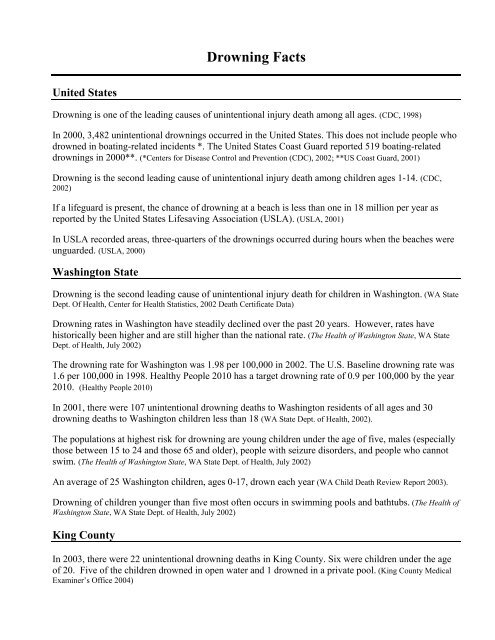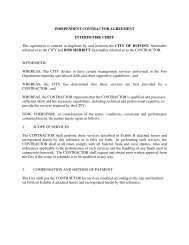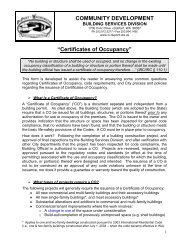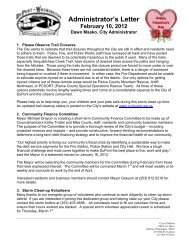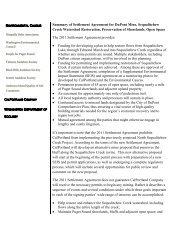Washington State Drowning Fact Sheet
Washington State Drowning Fact Sheet
Washington State Drowning Fact Sheet
You also want an ePaper? Increase the reach of your titles
YUMPU automatically turns print PDFs into web optimized ePapers that Google loves.
<strong>Drowning</strong> <strong>Fact</strong>s<br />
United <strong>State</strong>s<br />
<strong>Drowning</strong> is one of the leading causes of unintentional injury death among all ages. (CDC, 1998)<br />
In 2000, 3,482 unintentional drownings occurred in the United <strong>State</strong>s. This does not include people who<br />
drowned in boating-related incidents *. The United <strong>State</strong>s Coast Guard reported 519 boating-related<br />
drownings in 2000**. (*Centers for Disease Control and Prevention (CDC), 2002; **US Coast Guard, 2001)<br />
<strong>Drowning</strong> is the second leading cause of unintentional injury death among children ages 1-14. (CDC,<br />
2002)<br />
If a lifeguard is present, the chance of drowning at a beach is less than one in 18 million per year as<br />
reported by the United <strong>State</strong>s Lifesaving Association (USLA). (USLA, 2001)<br />
In USLA recorded areas, three-quarters of the drownings occurred during hours when the beaches were<br />
unguarded. (USLA, 2000)<br />
<strong>Washington</strong> <strong>State</strong><br />
<strong>Drowning</strong> is the second leading cause of unintentional injury death for children in <strong>Washington</strong>. (WA <strong>State</strong><br />
Dept. Of Health, Center for Health Statistics, 2002 Death Certificate Data)<br />
<strong>Drowning</strong> rates in <strong>Washington</strong> have steadily declined over the past 20 years. However, rates have<br />
historically been higher and are still higher than the national rate. (The Health of <strong>Washington</strong> <strong>State</strong>, WA <strong>State</strong><br />
Dept. of Health, July 2002)<br />
The drowning rate for <strong>Washington</strong> was 1.98 per 100,000 in 2002. The U.S. Baseline drowning rate was<br />
1.6 per 100,000 in 1998. Healthy People 2010 has a target drowning rate of 0.9 per 100,000 by the year<br />
2010. (Healthy People 2010)<br />
In 2001, there were 107 unintentional drowning deaths to <strong>Washington</strong> residents of all ages and 30<br />
drowning deaths to <strong>Washington</strong> children less than 18 (WA <strong>State</strong> Dept. of Health, 2002).<br />
The populations at highest risk for drowning are young children under the age of five, males (especially<br />
those between 15 to 24 and those 65 and older), people with seizure disorders, and people who cannot<br />
swim. (The Health of <strong>Washington</strong> <strong>State</strong>, WA <strong>State</strong> Dept. of Health, July 2002)<br />
An average of 25 <strong>Washington</strong> children, ages 0-17, drown each year (WA Child Death Review Report 2003).<br />
<strong>Drowning</strong> of children younger than five most often occurs in swimming pools and bathtubs. (The Health of<br />
<strong>Washington</strong> <strong>State</strong>, WA <strong>State</strong> Dept. of Health, July 2002)<br />
King County<br />
In 2003, there were 22 unintentional drowning deaths in King County. Six were children under the age<br />
of 20. Five of the children drowned in open water and 1 drowned in a private pool. (King County Medical<br />
Examiner’s Office 2004)
Key Strategies to Prevent <strong>Drowning</strong><br />
• <strong>Drowning</strong>s are preventable! Restricting swimming areas, providing proper signage, fencing pool<br />
areas and waterways, having lifeguard supervision, wearing life jackets, and carefully watching<br />
children while they bathe can eliminate most drownings.<br />
• KNOW YOUR LIMITS – <strong>Drowning</strong> often happens when someone swims and gets too tired. Ways<br />
to be safe: take swim lessons, learn to float and tread water, swim in lifeguarded areas, have<br />
parental/adult supervision, and avoid swimming while under the influence of alcohol or other drugs.<br />
• KNOW THE WATER – WA <strong>State</strong>’s lakes and rivers are cold enough to cause hypothermia, even<br />
in the summer and even among the strongest swimmers. Ways to stay safe: wear a lifejacket, avoid<br />
swimming or boating in high running water, check water conditions, never dive or jump into<br />
unfamiliar or shallow water, and swim in designated areas only.<br />
• WEAR A LIFEJACKET - People tend to drown in silence and without attracting attention. Their<br />
struggle to breathe and stay afloat rarely enables them to wave their arms or call for help. Also, 75%<br />
of boating fatalities could have been prevented if the victim was wearing a lifejacket.<br />
WA law requires children 12 and under to wear a Coast Guard approved lifejacket or life<br />
vest on vessels less than 19 feet long.<br />
For More Information<br />
• Injury and Violence Prevention, Public Health- Seattle & King County<br />
Pool and Water Safety<br />
www.metrokc.gov/health/injury/water.htm<br />
• Children’s Hospital and Regional Medical Center<br />
<strong>Drowning</strong> Prevention and Water Safety Information<br />
www.seattlechildrens.org/dp/ or www.drowning-prevention.org<br />
• American Red Cross Serving King and Kitsap Counties<br />
Home and Family Safety Tips<br />
www.seattleredcross.org/health/safety<br />
• <strong>Washington</strong> <strong>State</strong> Parks<br />
Boating Program<br />
www.parks.wa.gov/boating.asp<br />
• Army Corps of Engineers<br />
National Water Safety Program<br />
http://watersafety.usace.army.mil<br />
Updated by Virginia Lee & Eunyoung Lim<br />
Public Health-Seattle & King County<br />
Violence & Injury Prevention<br />
400 Yesler Way, Suite 500<br />
Seattle, WA 98104-2628<br />
June 2004


